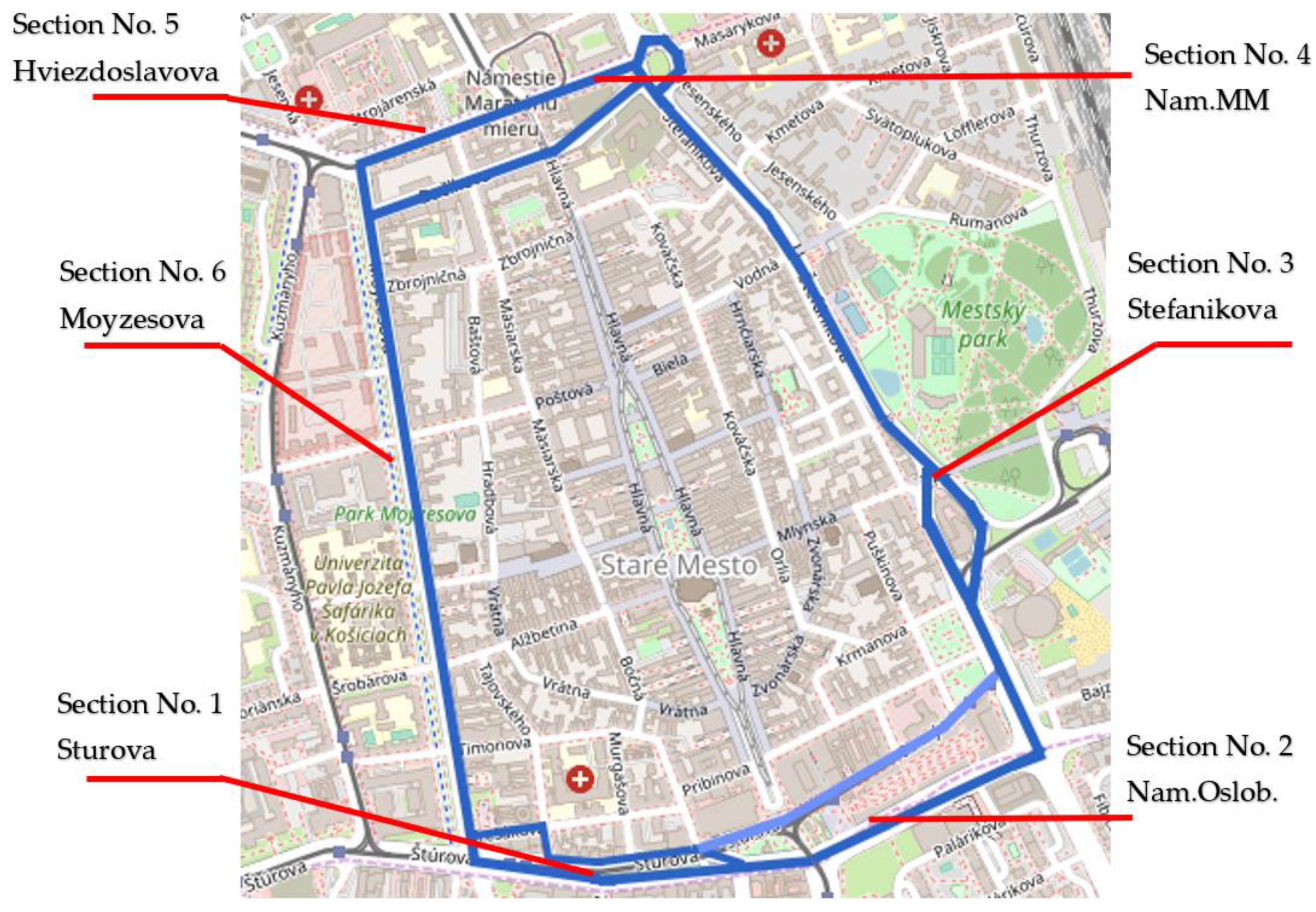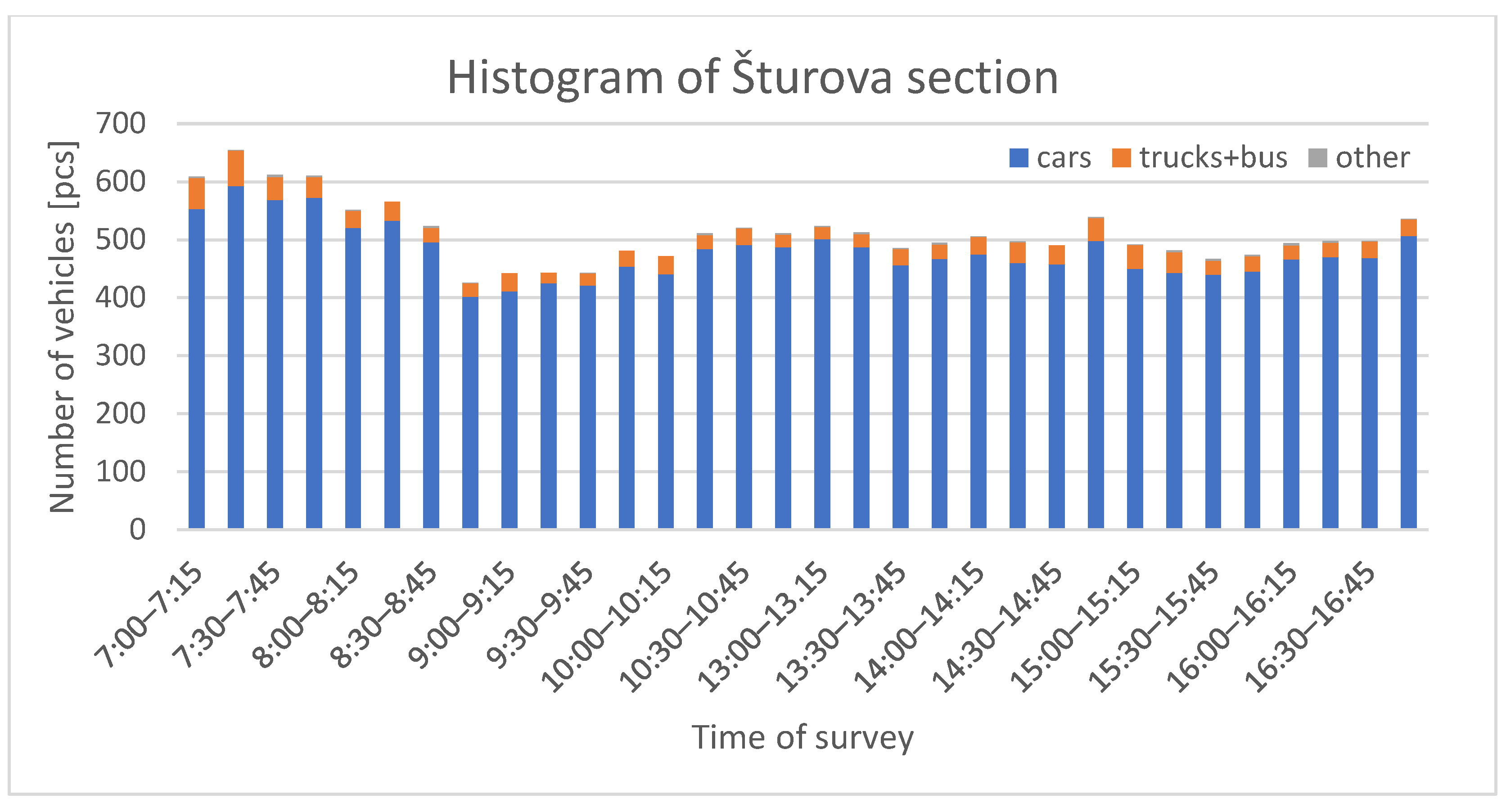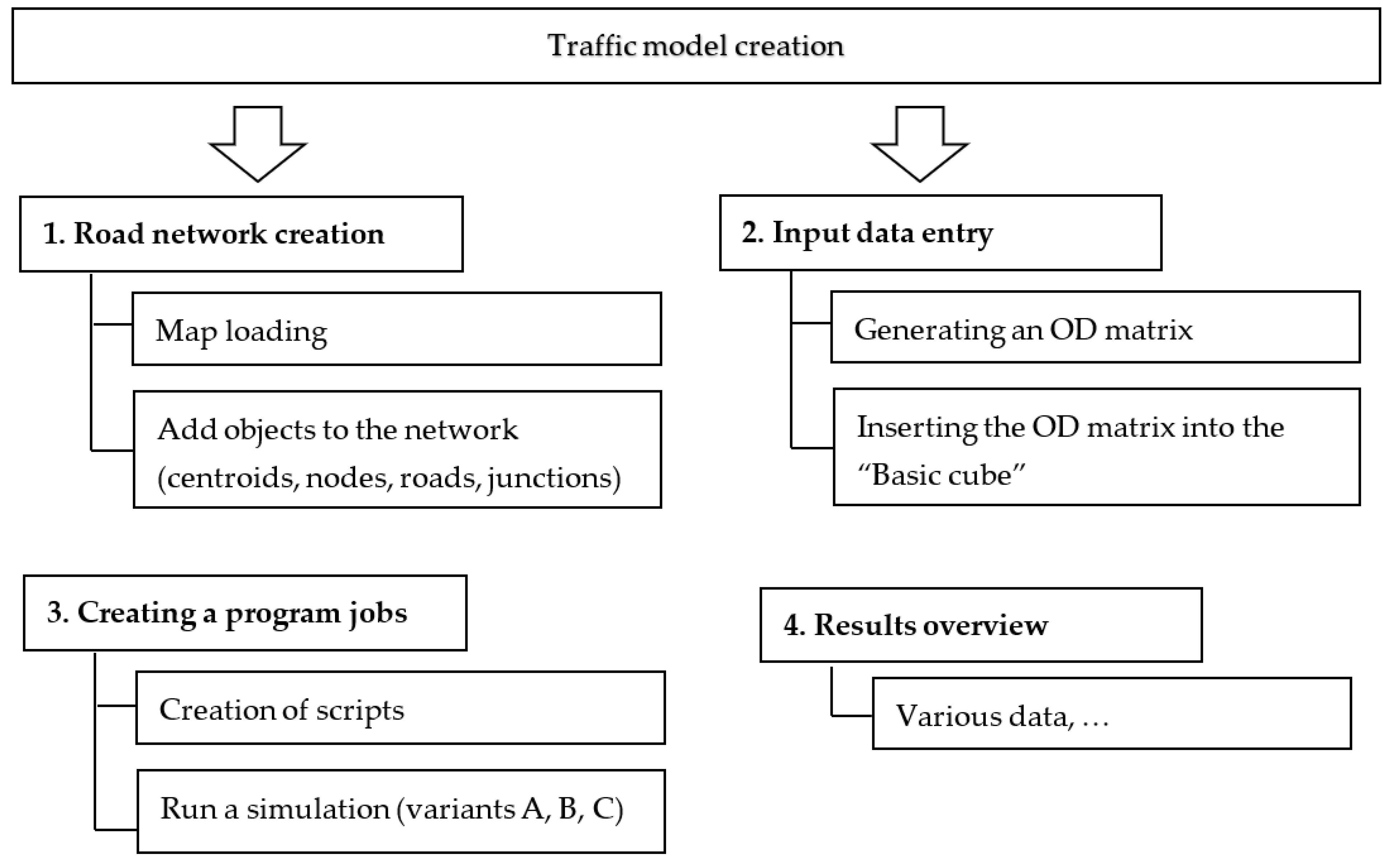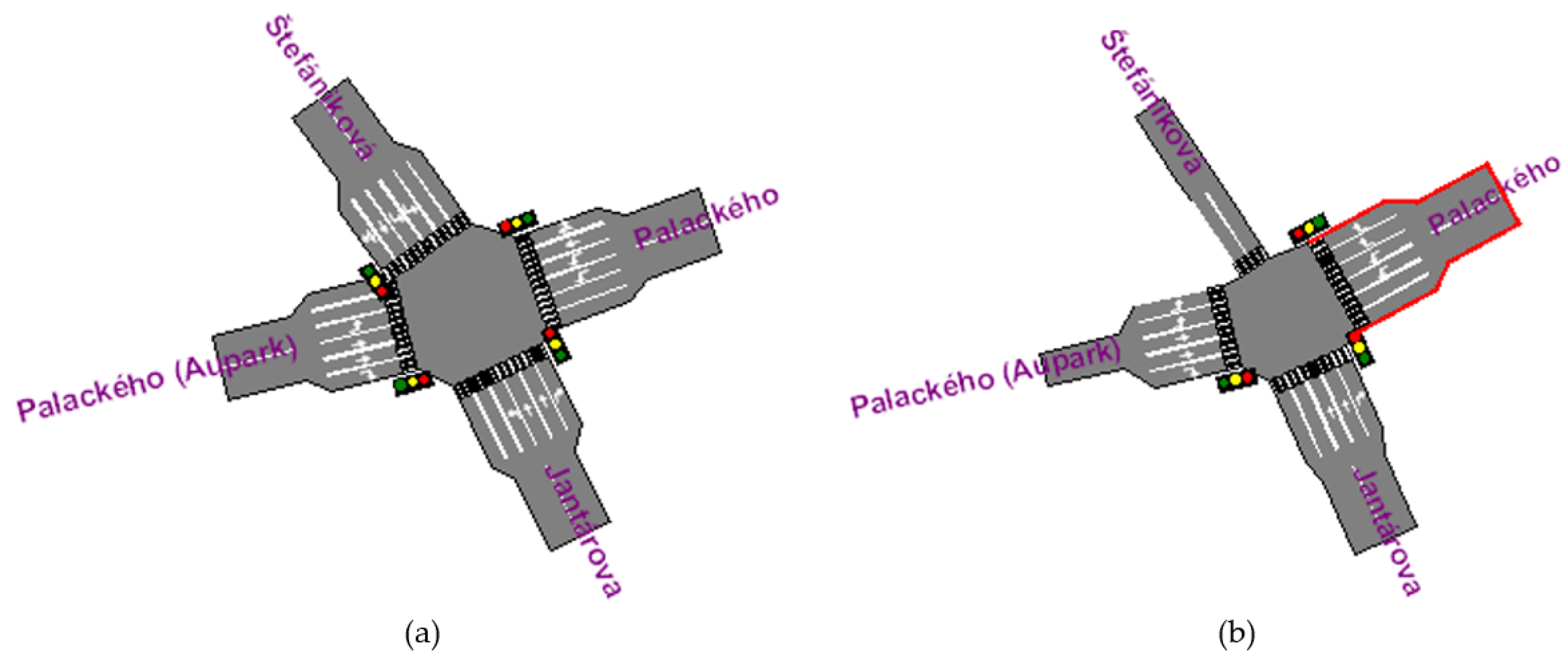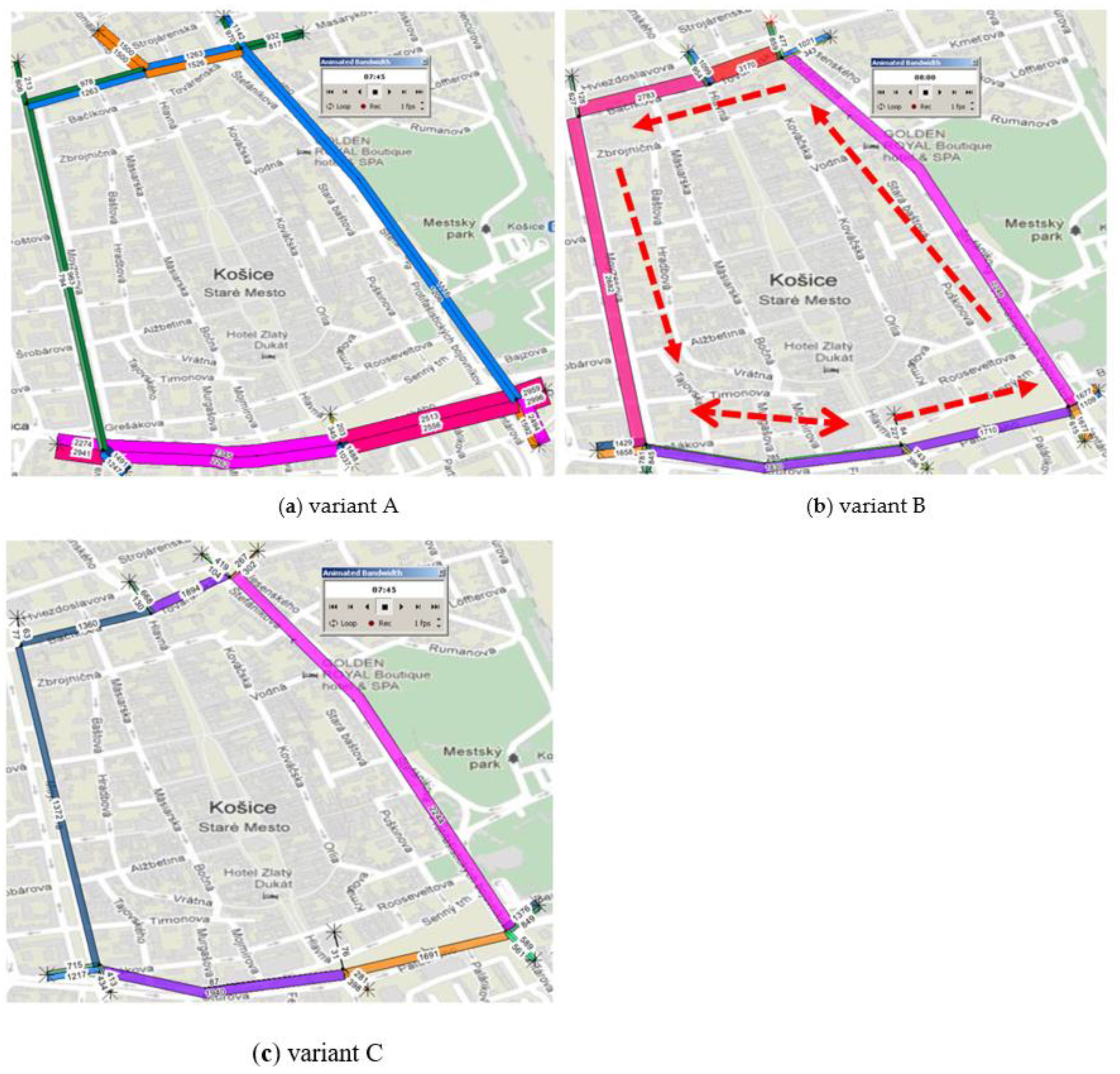1. Introduction
The development of cities, the increase in the number of inhabitants and their transport and the increasing attractiveness of activities in the town lead to higher demands on transport itself [
1]. Especially during peak times, traffic congestion is created due to the lack of capacity on urban roads. Because urban areas are denser and more congested, they could be expected to experience more significant induced demand effects than suburban, exurban, or rural settings [
2]. With the improvement in transportation and communication under globalization, the urban population continues increasing, while the rural population has been dwindling [
3,
4]. This fact is also confirmed by the projection of the development of the population in the book “Cities of the world: regional patterns and urban developments” [
5,
6]. Authors point out that the rural population will decrease in the next few decades and on the opposite side, by the 2050s, almost 62% of the global population will live in cities.
Any change in the traffic organization must be carefully considered as it can also have a negative impact on traffic. The aim of this study is to compare traffic intensities and road capacities before and after conversion to one-way traffic around the city center.
In the current trends in transport, it is not enough to increase the capacity of local roads just by expanding lanes. The extension of lanes is practically impossible and not desirable in cities with surrounding buildings. There is an opinion that widening roads at the level of the town will not solve congestion but will make the situation worse [
7].
Organizing transport in cities is not an easy task at all. It is practically impossible to find a universal solution for optimal transport organization because each city has its unique dimensions and features [
8].
Is a two-way road or a one-way system better? Many studies focusing on urban roads are struggling with these questions, but so far, there is no consensus on the optimal organization of transport aimed at improving urban mobility. Some publications deal with the change from a bidirectional to unidirectional circuit [
9,
10,
11,
12], while others address the change from reverse to one-way to two-way [
13,
14,
15,
16,
17,
18]. Especially in the U.S.A., there has been a noticeable trend in recent years when there is a conversion from one-way traffic to two-way traffic [
19]. Recently, urban decision makers and transportation planners resort to a one-way traffic system as an effective traffic management strategy, which profoundly affects traffic congestion and improves traffic flow, leading to urban sustainability [
11]. One-way streets undoubtedly have an advantage in static traffic, i.e., when parking, due to the unification of the street, it is possible to increase the number of parking spaces. In contrast, the negative impact of unidirectional on collisions, crime and the community are addressed in the study [
12]. One-way streets can simplify crossings for pedestrians, who must look for traffic in only one direction. While studies have shown that the conversion of two-way streets to one-way generally reduces pedestrian crashes, one-way streets tend to have higher speeds, which creates new problems [
20]. As a system, one-way streets can increase the travel distances of motorists and create some confusion, especially for non-local residents.
Other publications deal with the comparison of one-way vs. two-way communications from different perspectives. Examples are studies by Ortigosa and Yasuda et al. [
21,
22,
23,
24,
25]. Ortigosa, who focuses on various arrangements of road infrastructure in the urban environment, states that “
The design of urban street networks is a subject of much controversy because there is no consensus on the best way to organize streets to maximize mobility”. Quite often, publications deal with the ecological aspect of unidirectional vs. bidirectional; examples are included in the publications [
26,
27,
28].
The transport model can be understood as an idealized imitation of a part of the real world [
29,
30,
31,
32,
33]. The role of transport models is to model and subsequently predict transport behavior as a function of various inputs; finally, the models also appraise alternative scenarios to help policymakers choose the best solution from selecting alternatives [
34,
35]. There can be detected changes, e.g., situations that occur, such as changing the organization of transport or introducing traffic restrictions by using the transport model. Combining the principles of model construction and mathematical sets shows how some parts of a particular system react to changes in other parts of this system. The transport model is thus an attempt to imitate the actual transport process based on known laws. Traffic models are processed only for one specific territory. The term processing means creating a model structure, while the actual processing consists of calibration and validation. Usually, this is performed by a simulation of the developed model. Therefore, this model is sometimes called the traffic simulation model.
Transport models have a wide range of applications. Traffic models are used to optimize the design of proposed projects and produce critical input data for environmental impact assessments and cost–benefit analyses, such as expected time savings, safety effects, and changes in pollution and noise levels [
36].
There are several software products on the market for traffic modelling. For microsimulation models, the most used program appears to be VISSIM, which is used in many studies [
37,
38,
39,
40,
41,
42,
43,
44,
45,
46,
47,
48] and the AIMSUN program [
27,
49,
50,
51,
52,
53,
54]. Other studies, in turn, focus on comparing different software products. For example, in publication [
55], the authors compare Aimsun and OmniTRANS software when assessing junction capacity. More comparative studies [
50,
56,
57,
58,
59,
60] and research mostly do not point to significant differences between simulation tools. Although the results obtained by the simulation are slightly different from the measured values, the simulation models have an irreplaceable position in traffic planning and forecasting.
This article uses the OmniTRANS modelling tool. The OmniTRANS program enables the modelling of rail, road and urban public transport.
Perhaps the most critical point in traffic modelling is the data entering the traffic model. OmniTRANS works with the so-called OD matrix (Origin-Destination Matrix), representing the mutual transport relations between the individual areas in the created model. According to mathematical procedures and models, data in the OD matrix are traditionally obtained by extensive and precise traffic research in the solved area or by estimating the OD matrix. It is the latter option that is often used in practice, as traffic research is costly and time consuming. Until they are evaluated, the data are already so often outdated; thus, in the end, it is still necessary to estimate the matrix.
According to Bera and Rao, “The estimation of the up-to-date origin–destination matrix (ODM) from an obsolete trip data, using currently available information is essential in transportation planning, traffic management and operations.” [
61]. Many authors have been dealing with OD matrix estimation since 1970, and this trend continues to the present day when models for matrix estimation are constantly supplemented and improved, as is evident from the publications [
15,
61,
62,
63]. According to Smits [
62], OmniTRANS can use the following four types of data to estimate a matrix: traffic counts, screenlines, blocks and trip ends. A traffic count is located on a network link and contains information on the number of vehicles that pass that position. A screenline contains information on the total number of vehicles that pass several count locations. A block contains information on the total demand for a set of O-D pairs. A trip end is a particular case of a block; it contains information on a specific zone’s total production or attraction. The accuracy of this estimated matrix depends on the estimation model used, the input data errors, and on the set of links with collected traffic counts [
61].
2. Research Design and Methods
The transport system in the center of Kosice faces an increasing number of means of transport and emerging congestion, so Kosice has come up with a suggestion to streamline traffic on the town’s inner ring road, which serves the central city zone (CMZ). The town of Kosice is located in the eastern part of the Slovak Republic (
Figure 1) and is the second-largest city with approximately 250,000 inhabitants. For modelling, the simulation transport model is presented in this article.
The principle of this research is based on the comparison of traffic intensity on the monitored sections before and after the introduction of changes. Traffic intensity is defined as a measure of the average occupancy of an urban road during a specified period of time, normally a busy or peak hour. It is calculated as the ratio of the time during which a road is occupied to the time this road is available for occupancy. The aim is to reduce traffic congestion and the load on junctions due to introducing a one-way road. Load on junctions represents the number of vehicles on a junction road during the specified period of time. The methodology of the solution is shown in
Figure 2.
2.1. Study Area
The area of research focuses on the internal traffic circuit of Kosice (
Figure 3), which borders the historical zone of the city. The circuit provides mainly transport services to the central city zone (CMZ). CMZ in each city is characterized by a high density of buildings, increased mobility of pedestrians, traffic congestion and often the impossibility of widening lanes. Therefore, the possibilities for improving the traffic situation are minimal and, in principle, are reduced only to changes in the organization of transport or its appropriate management or eliminating the number of cars in city centers.
Currently, there is two-way traffic on the internal traffic circuit. This article aims to assess whether the proposed change from two-way to one-way traffic will positively affect the traffic situation in this inner ring road of the town. The suggestion assumes that some lanes used so far for two-way traffic would be available only for public transport, which would increase the attractiveness of public transport as an alternative to private transport.
The Traffic Research on Sturova Street
The indicative traffic research in the Sturova section (
Figure 4) revealed that the most critical time as of the number of cars passed is the hour between 7:00 and 8:00. It is the morning rush hour, so the study is focused only on the slot between 7:00 and 8:00. The research was performed at 15 min intervals from 7:00 to 17:00 during a regular working day.
2.2. The Calculation of Permissible Intensities on the Internal Circuit
The permissible traffic flow intensity I
p of the overall urban roads is calculated according to the relation (1) [
65]:
where
- Ip
permissible traffic flow [vehicle/h];
- Iz
the basic value of the permissible traffic flow intensity [vehicle/h];
- kk
coefficient of influence of a light-controlled junction [-];
- ks
width factor [-];
- km
maneuvering factor [-];
- kb
factor of very slow vehicle [-].
The basic values of the permissible traffic flow intensity I
z depend on the required speed, the proportion of slow vehicles and the longitudinal angle of the road. For a two-lane road, the values of I
z are in
Table 1, for a four-lane road in
Table 2 [
65].
The coefficient of influence of a light-controlled intersection k
k (
Table 3) depends on the ratio of the green phases at a given intersection and the distance in the intersection section.
The width factor k
s (
Table 4) expresses the influence of the width arrangement of the cross-section and the width of the lane on the permissible intensity of the traffic flow. In our case, all lanes on the inner circuit are 3.5 m wide. On some sections of the inner circuit road, there is a directionally divided road; on others, there is not.
The maneuvering factor k
m (
Table 5) expresses the effect of deceleration (stopping) of maneuvering vehicles in the urban road lane at:
- -
Turning or entering vehicles from the lane for parking or service on the associated lanes, on the stop lane, from adjacent buildings and less traffic-controlled intersections, etc.
- -
Standing on the lanes of vehicles operating adjacent objects, traffic lanes in front of pedestrian crossings and non-rail public transport vehicles.
The maneuvering factor is determined from the range of maneuvers of vehicles affecting the traffic conditions of the traffic flow in the evaluated sub-section of the intersection section. Maneuvers in the previous and next sub-section and starting from longitudinal parking and secondary urban road are not considered. The most unfavorable turning or stopping maneuvering factor is used to determine the permissible intensity.
The influence of very slow vehicles k
b in the traffic flow applies to the urban road with a proven regular occurrence of these vehicles. In our case, it is up to 2%, so the value of k
b is equal to 1 (
Table 6).
2.3. The Simulation Transport Model
The simulation traffic model is created to monitor and assess changes in the internal traffic circuit. It is made in the following three variants:
Variant A—the model of the current state of the internal traffic circuit with the two-way road;
Variant B—the model of the proposed change of the internal traffic circuit with consideration of one-way traffic;
Variant C—the model of the proposed change of the internal traffic circuit with the assumption of reducing the number of vehicles by 10%. In this variant, a reduction in the number of private cars by 10% is expected due to the greater use of public transport. The estimate of 10% is based on a short research among motorists, where 10% of the total number of 200 were in favor of the use of public transport after the unification of the inner circuit road of the city.
OmniTRANS traffic modelling program is used to create the model and simulate the three variants mentioned above. The traffic model can be in static or dynamic form. The second mentioned dynamic model is used in this article.
The output is a graphical representation of, e.g., traffic intensity, traffic network load in the static model. The output of the dynamic model is the load of the transport network in time intervals with the respective traffic volumes.
The program uses the OJL programming language to create traffic models. The OJL programming language works with simple and more complex scripts as needed, containing a group of simple commands. Separate scripts are divided into nine groups of modelling classes according to the type of modelling. The MADAM method is used for dynamic modelling in OmniTRANS [
66,
67].
All variants of the traffic model are created for the morning rush hour, i.e., between 7:00 and 8:00. The procedure for creating a simulation model is shown in
Figure 5.
2.3.1. Road Network Creation
The transport network of the internal transport circuit consists of 10 centroids, 6 nodes and 6 road sections (
Table 7).
Figure 6 shows a transport network with defined centroids, nodes and links. For Option B, the network consists of the equal number of districts, nodes and road sections. The change exists in the road section settings. Only one two-way road will remain from the current six two-way roads and the remaining five sections will be one-way roads with two lanes for private transport. The lane for buses in the transport model is not included. The layout changes when road traffic is redirected from Hviezdoslavova Street to Tovarenska and Bacikova Streets (
Figure 6b).
The nodes are placed where at least two road sections are connected. So, they are practically intersections. There are 5 light-controlled intersections and one roundabout intersection on the transport network. Two versions for each intersection were created, one for Variant A and one for Variants B and C. An illustrative example can be seen in
Figure 7a, which shows the light-controlled intersection of Palackeho (Aupark)–Jantarova for Variant A and
Figure 7b is the model of the intersection after the change to a one-way road (Variant B, C). A noticeable change is introducing a one-way road Stefanikova in the direction from the shown node to the northern sections of the internal traffic circuit.
The signal plan is set in the mode for morning rush hour “10: AM” and a cycle of 90 s.
Figure 8a shows the signal plan setting of the above light-controlled junction. An organizational change (one way) in the transport node also changes the signal plan (
Figure 8b). This means that, when the traffic organization is changed on the internal traffic circuit, changes in the settings of the signal plan will occur at all traffic nodes, while the cycle is not changed, but remains at 90 s.
2.3.2. Input Data to the Simulation Model
The OD matrix, which contains mutual transport relations between centroids, is needed to perform the simulation on the model created above. As mentioned above in this article, traditional methods for constructing an OD matrix involve extensive traffic research, which is done only once in a while, and it is very expensive and time-consuming [
61]. There are also situations where such research cannot be carried out due to financial or pandemic reasons. An example is a current situation where research could not be carried out as a result of the various restrictions caused by the COVID-19 pandemic, such as curfews, ordered work from home, etc. As a result, we could not provide accurate results due to reduced mobility.
Fortunately, OmniTRANS allows for estimating the OD matrix from old research. In our case, research conducted in 2015 can estimate the OD matrix [
68]. The methodology and algorithm for estimating the OD matrix are solved by several authors in their studies and are not interested in this article.
To estimate the OD matrix, we will use studies conducted in 2015 as part of the last national traffic census. The values of traffic intensity at all entrances and exits to/from the town’s internal traffic circuit were subtracted from the traffic survey provided in 2015. Based on these data, the so-called historical OD matrix for both Variant A and Variant B.
Table 8 shows the historical matrix for the current state, i.e., bidirectional traffic on the inner circuit (Variant A) and in
Table 9, the historical matrix for Variant B is compiled. The OD matrix for variant C is created from the historical source–target matrix for Variant B, with the number of vehicles reduced by 10%. The numbers of vehicles in the source–target matrices are rounded up to integers. The number of vehicles and the number of public transport funds was recorded.
Individual simulation experiments, conducted separately for each variant, were performed based on these input values. The simulation results are presented in the following chapter.
4. Conclusions
In this article, we have focused on the study of one-way traffic effects of the internal traffic circuit in the city of Kosice. The aim is to determine whether the change in the organization of transport, from two-way to one-way traffic, will have an impact on the change in its quality. For this purpose, we have used a traffic simulation model with three variants: Variant A represents the current situation, i.e., two-way traffic; Variant B represents the proposal of one-way traffic; Variant C represents one-way traffic with an expected decrease in the number of passenger cars of 10%.
We have assessed every variant in terms of the load percentage of each road section. To this end, we have adapted the traffic quality evaluation system shown in
Table 10, which is inspired by the LOS (Level of Service).
In general, the study reveals that the one-way nature of the traffic will not have any positive effect on the traffic situation on the internal traffic circuit of the city. The most advantageous variant in terms of the established system of transport quality level (
Table 11) is Variant A, which is the current state of transport organization. Regarding Variant B, the traffic quality level is reduced in all cases, with the exception of level D “unstable”. As can be seen in
Table 11, Variant C also results in quality-level reduction in each road section. In addition, if we consider other negative impacts of one-way traffic, such as a higher accident rate in the publication [
13], higher distance traveled or economic impacts [
14], then Variant A appears to be the most suitable alternative. On the other hand, there are cases in which one-way traffic can effectively reduce the total travel time of travelers in a certain congested urban area. Thus, as the results of the study [
11] show, the solution could be an introduction of one-way traffic only in some sections of the road. Additionally, the authors Chiu, Zhou and Hernandez [
15] state that one-way traffic may have advantages over two-way traffic under certain circumstances, so this topic requires further research.
The city of Kosice based its design of one-way traffic on the inner traffic circuit on experience with some new one-way streets in the city center, that brought an improvement in traffic flow, which resulted in an increase in the number of parking spaces. As this study has shown, the introduction of one-way traffic may not always be advantageous but definitely depends on many other factors, such as the need of creating new parking spaces, the presence of traffic lights, the number of vehicles in transit and others.
The uniqueness of the study lies in the fact that we have used a completely new approach to assess the suitability of two-way vs. one-way traffic by means of a load percentage on urban roads. None of the published studies known to us use this methodology. According to our literature research, most similar studies work with criteria such as Traffic intensity, Signal timing, Vehicle distance traveled, Average move time, Average speed or Fuel consumption. These are undoubtedly important criteria for the selection of road configuration but our study reveals that, when assessing the advantage of particular variant, we should focus not only on monitoring the intensities or time traveled by vehicles but also on the load percentage of the road section. As evident from the results in
Table 11, for Variant A, the ratio of urban road intensities with capacities is the most favorable. The load percentage on the roads here reaches excellent values when most of the sections are in quality grade A, B and only 2 sections are in quality grade C, which is still sufficient. With Variant B, we have only two lanes available for one-way traffic of passenger cars. This situation causes an increased load on the inner traffic circuit roads and a shift to grade D and, in one case, grade C.
In comparison with the available literature sources, the methodology used in this article brings a certain progressive element. The scientific and professional contributions of this study are as follows:
- -
Creating a traffic simulation model of the inner traffic circuit for the city of Kosice on which various traffic scenarios can be tested. The importance of traffic simulation models for traffic planning and forecasting in cities is enormous and allows traffic engineers to parametrically examine possible changes in traffic before these changes are made and thus optimize the traffic situation. Without a detailed traffic impact study approach, the traffic planners may always have to hold their breath on what may actually happen after the conversion.
- -
Proposal of a methodology for assessing the capacity of urban roads based on a traffic simulation model.
- -
Creating a categorization of road quality that can be acquired by other cities.
Most of the available studies use simulation models created in Vissim or Aimsun programs, but only a few publications deal with the simulation model in the OmniTRANS program, which is more affordable. Among the shortcomings and limitations of simulation models belong a risk that modeling assumptions become invalid for later applications of the model, or urban roads are subject to a variety of random disruptions that cannot be included in the model.
We would like to focus our future research on parametric study under the changing conditions of the created model. Here, we present an interesting alternative of two-way streets with prohibited left turns. We have not considered such an alternative yet, but the results of the study by Ortigosa [
21] indicate that this is the best compromise between distance traveled and capacity at intersections. Other questions remain open, such as studying congested vs. non-congested roads or finding a suitable combination of two-way traffic sections with one-way traffic sections.


